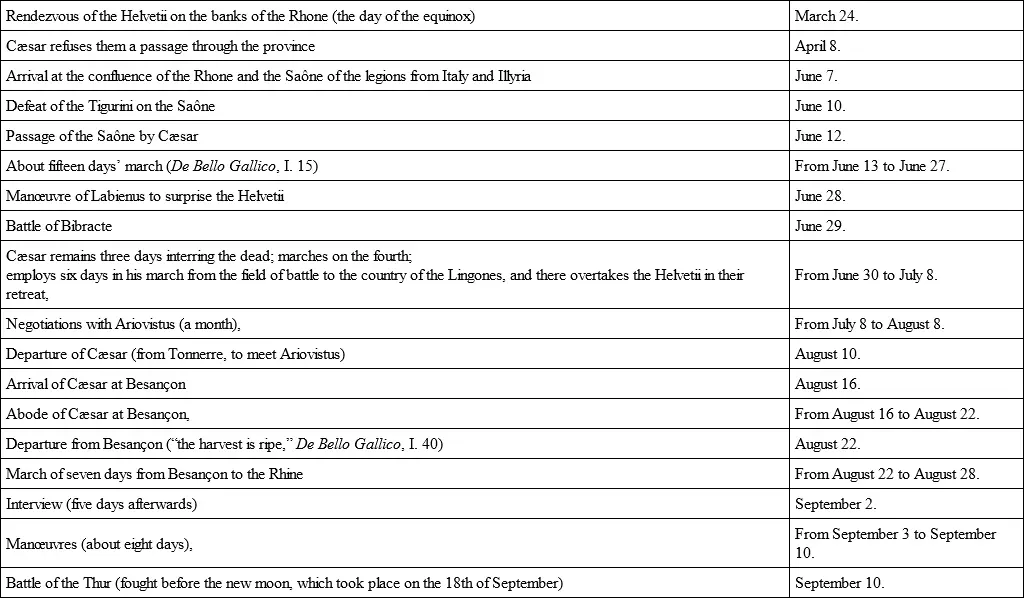Napoleon III - History of Julius Caesar Vol. 2 of 2
Здесь есть возможность читать онлайн «Napoleon III - History of Julius Caesar Vol. 2 of 2» — ознакомительный отрывок электронной книги совершенно бесплатно, а после прочтения отрывка купить полную версию. В некоторых случаях можно слушать аудио, скачать через торрент в формате fb2 и присутствует краткое содержание. Жанр: foreign_antique, foreign_prose, Биографии и Мемуары, на английском языке. Описание произведения, (предисловие) а так же отзывы посетителей доступны на портале библиотеки ЛибКат.
- Название:History of Julius Caesar Vol. 2 of 2
- Автор:
- Жанр:
- Год:неизвестен
- ISBN:нет данных
- Рейтинг книги:4 / 5. Голосов: 1
-
Избранное:Добавить в избранное
- Отзывы:
-
Ваша оценка:
- 80
- 1
- 2
- 3
- 4
- 5
History of Julius Caesar Vol. 2 of 2: краткое содержание, описание и аннотация
Предлагаем к чтению аннотацию, описание, краткое содержание или предисловие (зависит от того, что написал сам автор книги «History of Julius Caesar Vol. 2 of 2»). Если вы не нашли необходимую информацию о книге — напишите в комментариях, мы постараемся отыскать её.
History of Julius Caesar Vol. 2 of 2 — читать онлайн ознакомительный отрывок
Ниже представлен текст книги, разбитый по страницам. Система сохранения места последней прочитанной страницы, позволяет с удобством читать онлайн бесплатно книгу «History of Julius Caesar Vol. 2 of 2», без необходимости каждый раз заново искать на чём Вы остановились. Поставьте закладку, и сможете в любой момент перейти на страницу, на которой закончили чтение.
Интервал:
Закладка:
The report of this glorious exploit having spread beyond the Rhine, the Suevi, who had come to its banks, returned home. The Ubii, who dwelt near the river, pursued their terrified bands, and slew a considerable number of the fugitives.
Cæsar, having concluded two great wars in one single campaign, placed his army in winter quarters among the Sequani rather sooner than the season required – at the beginning of September – and left them under the command of Labienus. He then left, and went to hold the assemblies in Cisalpine Gaul. 237
Observations.
IX. There are several things worthy of remark in this campaign: —
1. The resolution taken by Cæsar to gain possession of Besançon, and thus to anticipate Ariovistus. We see the importance which he attaches to that military position as a point of support and of supply.
2. The facility with which a whole legion transforms itself into cavalry.
3. The judicious use which Cæsar makes of his light troops ( alarii ), by assembling them in mass, so that the enemy should believe in a greater number of legions.
4. Lastly, this singular circumstance, that the third line, which serves as reserve and decides the fate of the battle, receives from young P. Crassus, and not from the general-in-chief, the order to attack.
The dates of the principal events of this year may be indicated in the following manner: —

CHAPTER V.
WAR AGAINST THE BELGÆ
League of the Belgæ. Cæsar advances from Besançon to the Aisne.
I. THE brilliant successes gained by Cæsar over the Helvetii and the Germans had delivered the Republic from an immense danger, but at the same time they had roused the distrust and jealousy of most of the nations of Gaul. These conceived fears for their independence, which were further increased by the presence of the Roman army in Sequania. The irritation was very great among the Belgæ. They feared that their turn to be attacked would come when Celtic Gaul was once reduced to peace. Besides, they were excited by influential men who understood that, under Roman domination, they would have less chance of obtaining possession of the supreme power. The different tribes of Belgic Gaul entered into a formidable league, and reciprocally exchanged hostages.
Cæsar learnt these events in the Cisalpine province, through public rumour and the letters of Labienus. Alarmed at the news, he raised two legions in Italy, the 13th and 14th, and, in the beginning of spring, 238
sent them into Gaul, under the command of the lieutenant Q. Pedius. 239It is probable that these troops, to reach Sequania promptly, crossed the Great St. Bernard, for Strabo relates that one of the three routes which led from Italy into Gaul passed by Mount Pœrinus ( Great St. Bernard ), after having traversed the country of the Salassi ( Valley of Aosta ), and that this latter people offered at first to assist Cæsar’s troops in their passage by levelling the roads and throwing bridges across the torrents; but that, suddenly changing their tone, they had rolled masses of rock down upon them and pillaged their baggage. It was no doubt in the sequel of this defection that, towards the end of the year 697, Cæsar, as we shall see farther on, sent Galba into the Valais, to take vengeance on the mountaineers for their perfidious conduct and to open a safe communication with Italy. 240
As soon as forage was abundant, he rejoined his legions in person, probably at Besançon, since, as we have seen, they had been placed in winter quarters in Sequania. He charged the Senones and the other Celts who bordered upon Belgic Gaul to watch what was doing there and inform him of it. Their reports were unanimous: troops were being raised, and an army was assembling. Cæsar then decided upon immediately entering into campaign.
His army consisted of eight legions: they bore the numbers 7, 8, 9, 10, 11, 12, 13, and 14. As their effective force, in consequence of marches and previous combats, cannot have been complete, we may admit a mean of 5,000 men to the legion, which would make 40,000 men of infantry. Adding to these one-third of auxiliaries, Cretan archers, slingers, and Numidians, the total of infantry would have been 53,000 men. There was, in addition to these, 5,000 cavalry and a body of Æduan troops under the command of Divitiacus. Thus the army of Cæsar amounted to at least 60,000 soldiers, without reckoning the servants for the machines, drivers, and valets, who, according to the instance cited by Orosius, amounted to a very considerable number. 241
After securing provisions, Cæsar started from Besançon, probably in the second fortnight in May, passed the Saône at Seveux ( see Plate 4 ), crossed the country of the Lingones in the direction of Langres, at Bar-sur-Aube, and entered, towards Vitry-le-François, on the territory of the Remi, having marched in about a fortnight 230 kilomètres, the distance from Besançon to Vitry-le-François. 242
The Remi were the first Belgic people he encountered in his road ( qui proximi Galliæ ex Belgis sunt ). Astonished at his sudden appearance, they sent two deputies, Iccius and Adecumborius, the first personages of their country, to make their submission, and offer provisions and every kind of succour. They informed Cæsar that all the Belgæ were in arms, and that the Germans on that side of the Rhine had joined the coalition; for themselves, they had refused to take any part in it, but the excitement was so great that they had not been able to dissuade from their warlike projects the Suessiones themselves, who were united with them by community of origin, laws, and interests. “The Belgæ,” they added, “proud of having been formerly the only people of Gaul who preserved their territory from the invasion of the Teutones and Cimbri, had the loftiest idea of their own valour. In their general assembly, each people had engaged to furnish the following contingents: – The Bellovaci, the most warlike, could send into the field 100,000 men; they have promised 60,000 picked troops, and claim the supreme direction of the war. The Suessiones, their neighbours, masters of a vast and fertile territory, in which are reckoned twelve towns, furnish 50,000 men; they have for their king Galba, who has been invested, by the consent of the allies, with the chief command. The Nervii, the most distant of all, and the most barbarous among these peoples, furnish the same number; the Atrebates, 15,000; the Ambiani, 10,000; the Morini, 25,000; the Menapii, 7000; the Caletes, 10,000; the Veliocasses and the Veromandui, 10,000; the Aduatuci, 19,000; lastly, the Condrusi, Eburones, Cæresi, and Pæmani, comprised under the general name of Germans, are to send 40,000; in all, about 296,000 men.” 243
Cæsar’s Camp at Berry-au-Bac.
II. Cæsar could judge, from this information, the formidable character of the league which he had now to combat. His first care was to try to divide the hostile forces, and, with this view, he induced Divitiacus, in spite of the friendly relations which had long united the Ædui with the Bellovaci, to invade and ravage the territory of the latter with the Æduan troops. He then required the senate of the Remi to repair to his presence, and the children of the principes to be brought to him as hostages; and then, on information that Galba was marching to meet him, he resolved to move to the other side of the Aisne, which crossed the extremity of the territory of the Remi ( quod est in extremis Remorum finibus ), 244and encamp there in a strong position, to await the enemy’s attack. The road he had hitherto followed led straight to the Aisne, and crossed it by a bridge at the spot where now stands the village of Berry-au-Bac. ( See Plate 7. ) He marched in great haste towards this bridge, led his army across it, and fixed his camp on the right side of the road, on the hill situated between the Aisne and the Miette, a small stream with marshy banks, which makes a bend in that river between Berry-au-Bac and Pontavert. ( See Plate 8. ) This hill, called Mauchamp, is of small elevation (about 25 mètres) above the valley of the Aisne, and in its length, from east to west, it presents sufficient space for the Roman army to deploy. Laterally, it sinks to the level of the surrounding ground by slight undulations, and the side which looks upon the Miette descends by a gentle slope towards the banks of the stream. This position offered several advantages: the Aisne defended one side of the camp; the rear of the army was protected, and the transports of provisions could arrive in safety through the countries of the Remi and other friendly peoples. Cæsar ordered a work to be constructed on the right bank of the Aisne, at the extremity of the bridge, where he established a post ( see Plates 8 and 9 ), 245and he left on the other side of the river the lieutenant Q. Titurius Sabinus with six cohorts. The camp was surrounded by a retrenchment twelve feet high, and by a fosse eighteen feet wide. 246
Читать дальшеИнтервал:
Закладка:
Похожие книги на «History of Julius Caesar Vol. 2 of 2»
Представляем Вашему вниманию похожие книги на «History of Julius Caesar Vol. 2 of 2» списком для выбора. Мы отобрали схожую по названию и смыслу литературу в надежде предоставить читателям больше вариантов отыскать новые, интересные, ещё непрочитанные произведения.
Обсуждение, отзывы о книге «History of Julius Caesar Vol. 2 of 2» и просто собственные мнения читателей. Оставьте ваши комментарии, напишите, что Вы думаете о произведении, его смысле или главных героях. Укажите что конкретно понравилось, а что нет, и почему Вы так считаете.












